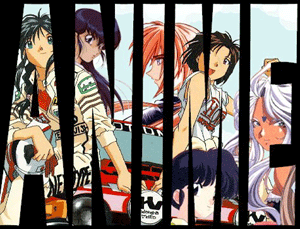
Note:
Have fun reading and then go watch some Anime!
Leach, 5 May 98
Anime? Isn't
that for children?
Japanese animation has been shown in Singapore for a long time now.
Many of us may still remember the "Xiao Ding Dang" (Doraemon)
& "Xiao Tian Tian" (Candy Candy) type cartoons we
watched when we were younger, though we may not have known then that it
was Anime. Currently, popular series such as Slam Dunk, Taiho Shichauzo
(You're Under Arrest!), Key the Metal Idol and Gunsmith Cats are shown
on cable TV. This exposure to Anime, although most times dubbed
in Mandarin, has made it much more accessible and acceptable to the majority
of Singaporean audiences.
However, it is unfortunate that Singaporeans have come to accept Disneyfied animation, but not Anime, as an acceptable medium for serious and realistic story telling. No one bats an eyelid at adults swarming to watch "The Lion King". But tell them you're going home to watch "Rurouni Kenshin" on AXN TV (cable), and they give you the look.
What is Anime?
Anime is not Mickey Mouse
and it's not necessarily for children. It is created for
all kinds of audiences spanning different age groups and different genres.
The subjects matter range from history to fantasy to science fiction and
adult (Hentai). It's slick, vibrant and detailed animation aimed
generally at mature audiences. It commonly features huge-eyed heroes/heroines,
fantastical worlds, super 3 in 1 transforming mechanical robots and fast-paced
action.
Anime as an Art
In Japan, Anime is considered to be an Art. Watching some productions
such as "Ghost in a Shell", it isn't difficult to see why.
Animation and film are considered to be one and the same medium in Japan.
The cinematography and other elements of professional film making are
all harnessed in the making of Japanese animated films. Anime artists
achieve the medium's distinct look by using a wider colour spectrum then
would be seen in a typical cartoon production; applying creative lighting,
focusing on minute details such as a reflected image on a spectacle lens
or the subtle glimmer of a tear; accurate historical contexts and intricate
mechanical devices; and experimenting with camera angles and abstract
backgrounds.
High Tech Anime
As far back as the 1980's, the implementation of digital mediums have
been used to enhance the look of Anime. Computer graphics were integrated
into cel animation to create new and revolutionary images - a seamless
blend of 2D and 3D. (This is unlike the 1994-98 Reboot-type animations).
The first such production was "Lensman" in 1984. Later,
Anime movies such as "Wings of Honneamise" used computer assisted
techniques. It was however not until the 1996 animation, "Ghost
in a Shell", that computers played a key role in Anime. And
Anime artists haven't looked back since.
To be or not
to be...
Anime is particularly appealing because of its unique design, storytelling
and presentation style. This is in part due to the fact that Anime
is not bound by the same constraints as conventional cartoons and that
directors tend to have more liberty than their counterparts.
Anime can be hilarious. But Anime can also be intense - exploring heavy themes through drama, emotional conflicts, multi-faceted character development and inter-protagonist relationships. Characters can exhibit complex personalities and moral ambiguity. In some productions, the hero could die a physical/moral death; there could be violence, sex, love, loss; there could even be religious, philosophical and psychological themes.
So, while children may watch the very popular "Neon Genesis Evangelion", you won't see them engaging in debate over its themes of social discussion and existentialism, nor will they notice the references to the Mandala of Kabalah, or to the Book of Revelations. I doubt that most adults viewers would either!
Convinced? Watch and judge for yourself!
Contrary to popular belief, the word "Anime" is not the Japanese word for animation. It is actually derived from a French word!
Manga
Mangas are "comic" publications with phone book quality
paper and binding. These publications come in bi-weekly and monthly editions.
Interestingly, Mangas are only a couple of rungs beneath newspapers in
social status, so it is not uncommon to see working adults reading manga
while on the way to work.
Savage, Lorraine - "The Anime Invasion" in CGW April 1998.
Barlow, Elaine - "What is Anime" at Annimecca © 1997,98 The AnimeOnline Network/Mecca Publications